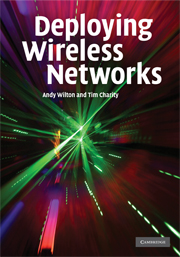Book contents
- Frontmatter
- Contents
- Foreword by Sir David Brown, FREng
- Preface
- Acknowledgements
- Authors' disclaimer
- 1 Introduction
- 2 Wireless network systems
- 3 Principles of access network planning
- 4 Introduction to RAN planning and design
- 5 GSM RAN planning and design
- 6 UMTS RAN planning and design
- 7 Cellular OFDM RAN planning and design
- 8 Mesh network planning and design
- 9 Core network and transmission
- 10 Network operation and optimisation
- Acronyms
- Index
- References
4 - Introduction to RAN planning and design
Published online by Cambridge University Press: 13 August 2009
- Frontmatter
- Contents
- Foreword by Sir David Brown, FREng
- Preface
- Acknowledgements
- Authors' disclaimer
- 1 Introduction
- 2 Wireless network systems
- 3 Principles of access network planning
- 4 Introduction to RAN planning and design
- 5 GSM RAN planning and design
- 6 UMTS RAN planning and design
- 7 Cellular OFDM RAN planning and design
- 8 Mesh network planning and design
- 9 Core network and transmission
- 10 Network operation and optimisation
- Acronyms
- Index
- References
Summary
In Chapter 3, the generic principles, processes and deployment configurations applicable to cellular network planning were developed. In this chapter and the following four, a detailed design process will be developed to address, step by step, the practical deployment process for four different wireless networks.
This chapter describes the steps in the planning process that are essentially common, regardless of the specific air interface under consideration. The high-level planning of Chapter 3 will have estimated the total number of cell sites and the maximum cell size, and made decisions on the applications to be deployed. The detailed plan will define the actual locations of cell sites, antenna types, mast heights, etc., using topographical data for the specific regions. The plan will also assure guaranteed levels of coverage, capacity and availability for the applications to be supported.
The changing relative implementation cost and impact on battery life of particular technologies at points in time over the last 25 years has given rise to three distinct RAN standards:
TDMA (as employed in GSM, GPRS, EDGE),
CDMA (as employed in UMTS releases 99, 4, 5, 6, 7 and CDMA 2000),
OFDMA (as employed in 802.11, 802.16e (WiMAX) and as planned for 3G LTE).
These technologies are expected to dominate wireless deployments over the next 20 years and it is a comprehensive understanding of major factors, such as coverage, capacity and latency, that will enable system designers to exploit their potential fully.
Information
- Type
- Chapter
- Information
- Deploying Wireless Networks , pp. 82 - 99Publisher: Cambridge University PressPrint publication year: 2008
